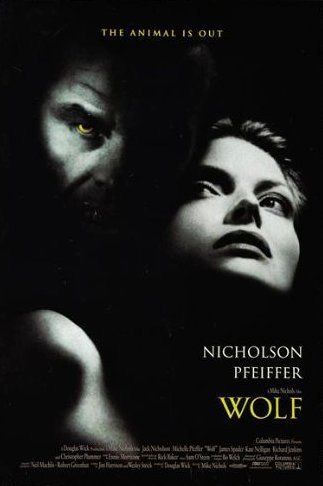 For those wondering why nineties horror generally gets such a bad rap, consider this Exhibit #1. A bloated werewolf movie headlined by Jack Nicholson and Michele Pfeiffer, WOLF is undeniably slick, but also empty, clichéd and forgettable.
For those wondering why nineties horror generally gets such a bad rap, consider this Exhibit #1. A bloated werewolf movie headlined by Jack Nicholson and Michele Pfeiffer, WOLF is undeniably slick, but also empty, clichéd and forgettable.
There were some worthwhile horror films in 1994, including THE CROW, Jan Svankmajor’s FAUST, HEAVENLY CREATURES and the first installment of THE KINGDOM, but this mega-budgeted disaster, released on June 17 (the very day O.J. Simpson tied up L.A.’s freeways in that never-to-be-forgotten white Bronco), was more representative of what the year—and the decade overall—had to offer horror-wise, bookended by as it was by the equally clunky MARY SHELLEY’S FRANKENSTEIN.
WOLF’S problems started with the inexplicable choice of Mike Nichols as director, apparently by its star Jack Nicholson. Among those who protested Nichols’ hiring was author Jim Harrison, upon whose 1981 novel WOLF: A FALSE MEMOIR this film was (very) loosely adapted. Harrison actually quit the movie world, he claims, because of his immense (and entirely understandable) dissatisfaction with WOLF.
Will Randall is a wealthy New York publishing executive who while driving down a rural New England road one night runs over, and gets bitten by, a wolf. From there he finds himself afflicted by debilitating stomach cramps, sleeping spells and an unusually acute sense of smell.
At a party Will meets Laura Alden, a rich blonde. She becomes increasingly important in Will’s life as his issues grow more acute, culminating in him sprouting fur and fangs and killing a deer by the light of a full moon.
Will also has to contend with office politics, which prove every bit as cutthroat as the law of the jungle. A competitive co-worker named Stewart is angling to take Will’s job, and also (as his wolf senses inform him) his wife Charlotte. During a confrontation he bites Stewart, an act to which Will initially pays little attention.
Will’s moonlit exploits, meanwhile, continue unabated: he kills some muggers in Central Park and uses his newfound animal wiles to outmaneuver Stewart in the office. Will’s odd behavior naturally arouses Laura, who gains entrance to his apartment one night and has her way with him. The following morning Will and Laura are visited by police inspectors who inform them that Charlotte was killed during the night, her throat ripped out…as if by a wild animal.
Laura attempts to contain Will by taking him back to her New England home and locking him up, not realizing that Stewart (who, you’ll recall, was bitten by Will) is afoot in the area, and still determined to take Will’s job—and also his life.
The late Mike Nichols may have been one of Hollywood’s most respected filmmakers, but his attempts at thriller moviemaking (like THE DAY OF THE DOLPHIN and THE FORMULA) didn’t add up to much, and neither does WOLF. Despite having been visualized by the great Giuseppe Rotunno (Federico Fellini’s cinematographer of choice) it has a bland, pallid look, accentuated by the cruddy poor man’s processing in driving car shots, patently stagey “wilderness” scenes and ho-hum wolf transformation effects—plus the pic is supposed to be set in New York City, yet the office where much of it takes place is clearly located in L.A.’s iconic Bradbury building. Further annoyances include the ridiculous Eddie Munster hairdos sported by Jack Nicholson and James Spader during their wolf transformations, and the none-too-surprising “surprise” ending in which we learn that a third character has been infected with the werewolf virus.
Nichols’ attempts at poetic mise-en-scene fall flat, with a scene in which Jack Nicholson howls at the moon in the middle of Central Park playing about as well as it sounds, while a promising bit in which Nicholson “marks his territory” by peeing on James Spader’s shoes falls flat due to the blandness of the filmmaking. Even the much-remarked-upon fact that the word “werewolf” is never mentioned isn’t novel—see the 1992 John Landis vampire flick INNOCENT BLOOD, which pointedly refrained from utilizing the term “vampire.”
In true Hollywood blockbuster fashion, there’s a cast of familiar faces in addition to Nicholson, Pfeiffer and Spader, including Kate Nelligan as Nicholson’s wife, David Hyde Pierce as an underling and Christopher Plummer as Nicholson’s superior, whose competent but soulless performances only serve to accentuate WOLF’S impersonal feel.
Vital Statistics
WOLF
Columbia Pictures
Director: Mike Nichols
Producer: Douglas Wick
Screenplay: Jim Harrison, Wesley Strick
Cinematography: Giuseppe Rotunno
Editing: Sam O’Steen
Cast: Jack Nicholson, Michelle Pfeiffer, James Spader, Kate Nelligan, Richard Jenkins, Christopher Plummer, Eileen Atkins, David Hyde Pierce, Om Puri, Ron Rifkin, Prunella Scales, Brian Markinson, Peter Gerety
